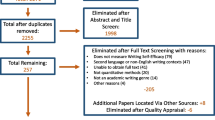Abstract
Letters of reference are commonly used in acquiring a job in education. Despite serious issues of validity and reliability in writing and evaluating letters, there is a dearth of research that systematically examines the evaluation process and defines the constructs that define high quality letters. The current study used NVivo to examine 160 letters of reference to determine component constructs and relate these components to overall letter quality. Results suggest that testimonials are most predictive of overall letter quality. Implications and limitations of this study are also discussed.
Similar content being viewed by others
References
Aamodt, M. G., Bryan, D. A., & Whitcomb, A. J. (1993). Predicting performance with letters of recommendation. Public Personnel Management, 22(1), 81–90.
Bolz, A. J. (2009). Screening teacher candidates: Luck of the draw or objective selection. Ph.D. Dissertation, University of Wisconsin, Madison.
Brown, L. L. (1999). Fourteen ways to write a better letter of recommendation. Professional School Counseliing, 3(2), 141–147.
Cannell, J. J. (1989). The “Lake Woebegone” report: how public educators cheat on standardized achievement tests. Albuquerque: Friends for Education.
Ceci, S. J., & Peters, D. (1984). Letters of reference: a naturalistic study of the effects of confidentiality. American Psychologist, 39(1), 29–31.
Friedman, R. B. (1983). Fantasy land. The New England Journal of Medicine, 308(11), 651–653.
Kennen, E. (2008). Sample letters of recommendation. Retrieved on 4/20/2010 from: http://teachertipstraining.suite101.com/article.cfm/sample_letters_of_recommendation.
Mason, R. W., & Schroeder, M. P. (2010). Principal hiring practices: toward a reduction of uncertainty. The Clearing House, 83(5), 186–193.
Miller, R. K., & Van Rybroek, J. (1988). Internship letters of recommendation: where are the other 90 %? Professional Psychology: Research and Practice, 19(1), 115–117.
Morrison, N. (2007). So, are you good to glow. Times Educational Supplement, 4722, 32.
NVivo 8. (1999–2009). Cambridge, MA: OSR International (Americas) Inc. Questions about and objections to the Buckley amendment – The family rights and privacy act of 1974 (Sec. 513 of P.L. 93-380) – and responses. Congressional Record – Senate. 120(Part 27), 36532–36535.
Peres, S. H., & Garcia, J. R. (1962). Validity and dimensions of descriptive adjectives used in reference letters for engineering applicants. Personnel Psychology, 15(3), 279–286.
Ryan, M., & Martinson, D. L. (2000). Perceived effects of exaggeration in letters of recommendation. Journalism & Mass Communication Educator., 55(1), 40–52.
Schaffer, D. R., & Tomarelli, M. (1981). Bias in the ivory tower: an unintended consequence of the Buckley amendment for graduate admission? Journal of Applied Psychology, 66(1), 7–11.
Schaffer, D. R., Mays, P. V., & Etheridge, K. (1976). Who shall be hired: a biased effect of the Buckley amendment on employment practices? Journal of Applied Psychology, 61(5), 571–575.
Schneider, A. (2000). Why you can’t trust letters of recommendation. The Chronicle of Higher Education, 46(43).
Toglia, T. V. (2004). Writing recommendation letters – without the stress. Tech Directions, 63(8), 24–25.
Wechler, H. (1982). How to write – and read – letters of recommendations. Medical Economics, 59(17), 145–146. 151–152, 156.
Wright, S. M., & Ziegelstein, R. C. (2004). Writing more informative letters of reference. Journal of General Internal Medicine, 19(5), 588–593.
Author information
Authors and Affiliations
Corresponding author
Appendices
Appendix A

Appendix B
LETTERS OF REFERENCE ASSESSMENT SCALE (3 × 5)
Scale: | 1= Poor | 3= Satisfactory | 5= Excellent |
|---|---|---|---|
I. Interpersonal Skills | Little or no interpersonal skills referenced | One interpersonal skill referenced | Many interpersonal skills referenced |
II. Superlatives | Little or no superlative words used | Three superlatives used | Five or more superlatives used |
III. Testimonials | Student is not recommended | Student is recommended | Student is highly recommended |
IV. Teacher Traits | Little or no distinguishing teacher traits given | Three teacher traits given | Five or more teacher traits given |
V. Overall Impression | Weak impression of student teacher | Average impression of student teacher | Outstanding impression of student teacher |
Rights and permissions
About this article
Cite this article
Mason, R.W., Schroeder, M.P. Student teacher letters of reference: A critical analysis. Educ Asse Eval Acc 24, 307–323 (2012). https://doi.org/10.1007/s11092-012-9152-8
Received:
Accepted:
Published:
Issue Date:
DOI: https://doi.org/10.1007/s11092-012-9152-8




